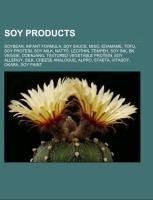
-
 Anglický jazyk
Anglický jazyk
Soy products
Autor: Source: Wikipedia
Source: Wikipedia. Pages: 65. Chapters: Soybean, Infant formula, Soy sauce, Miso, Edamame, Tofu, Soy protein, Soy milk, Natto, Lecithin, Tempeh, Soy ink, BK Veggie, Doenjang, Textured vegetable protein, Soy allergy, Silk, Cheese analogue, Alpro, Staeta,... Viac o knihe
Na objednávku, dodanie 2-4 týždne
18.27 €
bežná cena: 20.30 €
O knihe
Source: Wikipedia. Pages: 65. Chapters: Soybean, Infant formula, Soy sauce, Miso, Edamame, Tofu, Soy protein, Soy milk, Natto, Lecithin, Tempeh, Soy ink, BK Veggie, Doenjang, Textured vegetable protein, Soy allergy, Silk, Cheese analogue, Alpro, Staeta, Vitasoy, Okara, Soy paint, Soybean oil, Kongnamul, Tuong, Oncom, Tofu skin, Tian mian jiang, Soy yogurt, Dajiang, Soybean wars of Paraguay, Cheonggukjang, Amoy Food, Yellow soybean paste, Douchi, Fermented bean paste, Soy candle, Ganjang, Protein dispersibility index, Soy molasses, Friedrich J. Haberlandt, Doubanjiang, So Good, Mamenori, 8th Continent, IOM soybeans, Beanfeast, Soy sauce chicken, Archer Farms, Lufu, Tauchu, Fermented soy products, Soy nut. Excerpt: The soybean (U.S.) or soya bean (UK) (Glycine max) is a species of legume native to East Asia, widely grown for its edible bean which has numerous uses. The plant is classed as an oilseed rather than a Pulse (legume) by the Food and Agricultural Organisation (FAO). Fat-free (defatted) soybean meal is a primary, low-cost, source of protein for animal feeds and most prepackaged meals; soy vegetable oil is another product of processing the soybean crop. For example, soybean products such as textured vegetable protein (TVP) are ingredients in many meat and dairy analogues. Soybeans produce significantly more protein per acre than most other uses of land. Traditional nonfermented food uses of soybeans include soy milk, and from the latter tofu and tofu skin. Fermented foods include soy sauce, fermented bean paste, natto, and tempeh, among others. The oil is used in many industrial applications. The main producers of soy are the United States (35%), Brazil (27%), Argentina (19%), China (6%) and India (4%). The beans contain significant amounts of phytic acid, alpha-linolenic acid, and the isoflavones genistein and daidzein. The plant is sometimes referred to as greater bean (¿¿ - Chinese dàdòu and Japanese daizu). Both the immature soybean and its dish are called edamame in Japan, but in English, edamame refers only to a specific dish. The English word "soy" is derived from the Japanese pronunciation of shoyu ), the Japanese word for soya sauce; "soya" comes from the Dutch adaptation of the same word. Varieties of soybeans are used for many purposes.The genus name Glycine was originally introduced by Carl Linnaeus (1737) in his first edition of Genera Plantarum. The word glycine is derived from the Greek - glykys (sweet) and likely refers to the sweetness of the pear-shaped (apios in Greek) edible tubers produced by the native North American twining or climbing herbaceous legume, Glycine apios, now known as Apios americana. The cultivated soybean first appeared in Species
- Vydavateľstvo: Books LLC, Reference Series
- Rok vydania: 2012
- Formát: Paperback
- Rozmer: 246 x 189 mm
- Jazyk: Anglický jazyk
- ISBN: 9781157610700









 Nemecký jazyk
Nemecký jazyk 

 Španielsky jazyk
Španielsky jazyk 
